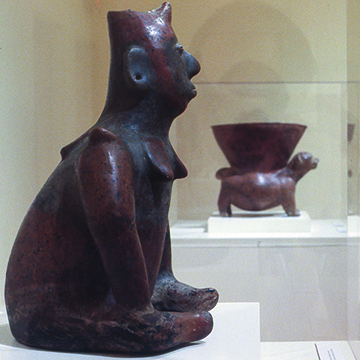Ancient Mexico · Ceramic Vessels from Colima and Casas Grandes
Before the Spanish conquest, Mexico had enjoyed over 3,500 years of cultural development, the richness of which still exists in fine and diverse ceramics. This exhibition features ceramic vessels from two distinctive cultural traditions in ancient Mexico.
Much of our knowledge of the people of Colima, a culture that flourished on the Pacific coast of Mexico from about 200 BCE to 300 CE, comes from an examination of the mortuary ceramics found in their elaborate tombs. The ceramics in the JCCC exhibition depict a variety of animals, plants and human activities, including couples embracing or sitting sedately, dogs snarling and intricately modeled plants such as squash and cactus. Although painted decoration and texturing was used sparingly, most Colima ceramics portray motion, vitality and dynamism and are highly regarded as sculptural works.
The culture of Casas Grande, on the extreme northern frontier of Mexico, flourished much later — from 1150 to 1350 — and had a profound influence on the civilizations of the American Southwest. The sophisticated ceramics from Casas Grande are generally decorated with solid black and red geometric elements and complex fine lines. The symmetry and thin walls of the clay bodies are remarkable in the absence of a potter's wheel. Elaborate compositions include stylized bird, serpent and human motifs that depict themes of death and sacrifice. Seated male smokers, bighorn sheep, badgers and fish are also represented.
Within 200 years of the decline of the Casas Grande culture, the voyage of Columbus and the resulting collision of two worlds changed forever the cultural development of Mexico. The exhibition is another in a series of special events this fall at JCCC focusing attention on Mexico in an effort to encourage greater understanding between our two nations.
The gallery guide features an essay by Barbara L. Moulard, museum curator, Pueblo Grande Museum and Cultural Park, Phoenix, Arizona.





